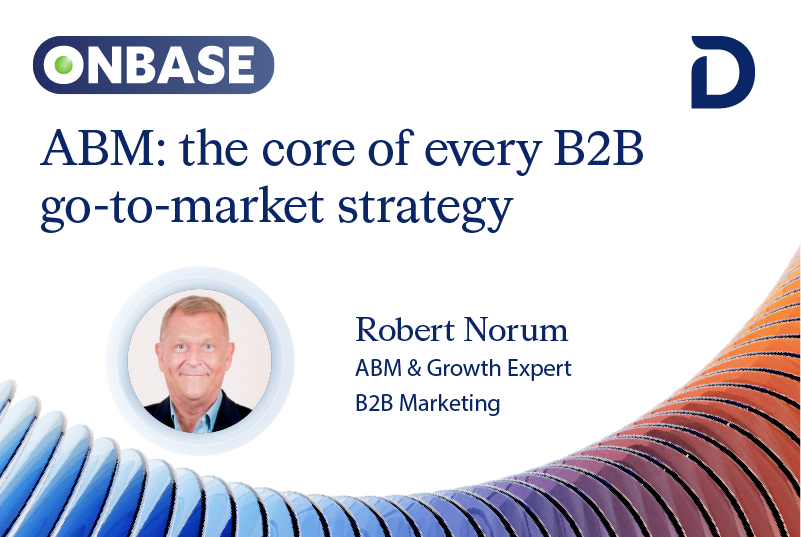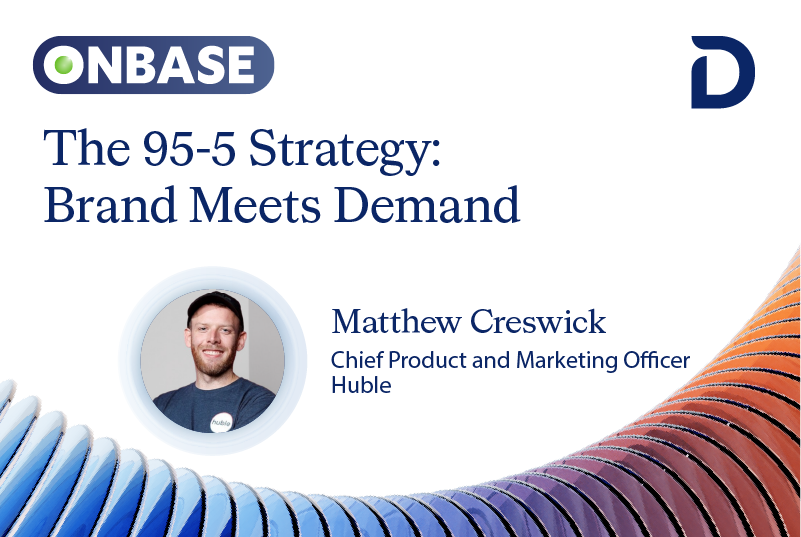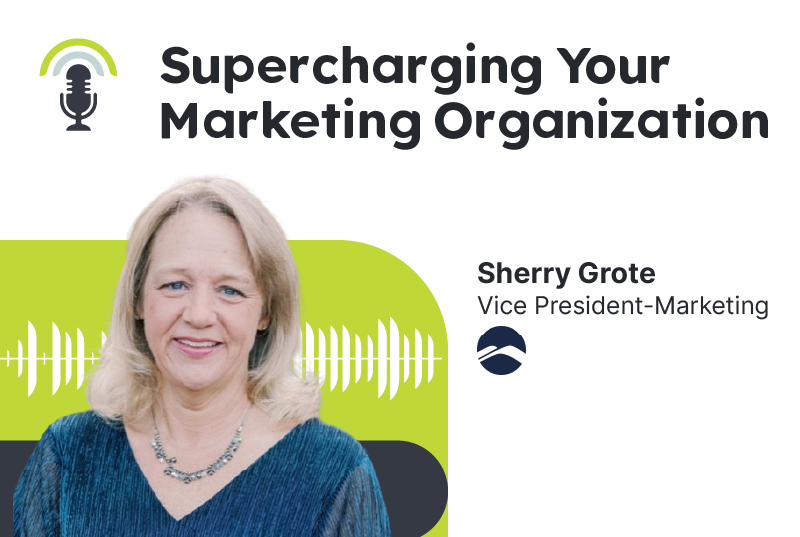
Supercharging Your Marketing Organization
Shownotes
On this episode of Sunny Side Up, host Rory Costello speaks with marketing expert Sherry Grote about supercharging your marketing organization. Sherry shares her experience building high-performing teams and emphasizes the importance of collaboration between sales and marketing teams. They discuss tactics for facilitating this collaboration and highlight the need for nimble, results-driven approaches. Sherry also shares her playbook for achieving growth through effective marketing strategies, including building a demand gen engine, partnering with the right companies, and creating hyper-personalized account-based approaches.
About the Guest
Sherry Grote is an experienced and passionate marketing leader. Over the last 25 years, she has proven to be a results-driven leader – building and mentoring high-performing marketing teams while fostering collaboration across organizations to deliver pipeline and revenue that promotes high growth for B2B SaaS companies.
Key Takeaways
- Sherry emphasizes the importance of alignment between sales and marketing for generating pipeline and revenue
- Sherry has experience building and scaling demand gen programs at startups and established companies
- She enjoys the challenge of starting from scratch and making a difference in the lives of the people she works with
- The first step in building a successful marketing organization is identifying the value proposition
- Overcoming limitations and lack of resources in early stage startups
- Creating lightning strikes and provocative marketing materials
- Giving space for employees to be creative and bring their ideas to the table
- Building consensus among the leadership team and focusing on the results
- Building a digital foundation at Blue Ridge required building infrastructure from scratch, including Google AdWords, LinkedIn presence, and a new website.
- Playbooks for net new logo acquisition, customer marketing, channel marketing, and SDR/BDR/ADR teams were developed to drive pipeline and revenue.
- Having an SDR/BDR/ADR team sitting within marketing helps eliminate challenges between sales and marketing
Quote
“Building a bridge between sales and marketing is crucial for success, and having a team that qualifies leads can eliminate the challenges that exist between the two departments.”
– Sherry Grote
Highlights from the Episode
Have you gained experience in implementing and scaling marketing programs for organizations of various sizes? Can you share some insights on where to begin when taking the lead in a marketing program?
Sherry has extensive experience in scaling marketing programs for organizations of varying sizes, having worked with startups and established organizations alike. Her advice for taking the lead in a marketing program is to start with a clear understanding of the company’s objectives and target audience, develop a comprehensive strategy, and execute it with a strong team. She emphasizes the importance of collaboration, communication, and flexibility in navigating the ever-changing marketing landscape.
Are you leaning more toward the startup and the startup with legs? What makes it different and what gets you excited to work with an organization that’s in that stage of their growth and development, at least in terms of a challenge?
Sherry explains that for her, it’s important to tie what she does and who she is together to find energy for work-life balance. She needs to be able to put her fingerprints on something and make a difference not just in work, marketing, or growth, but also in the lives of the people involved. Sherry has had the pleasure of doing this in a few places and still has great relationships with the people she worked with. This is why she prefers to work with organizations that are in the startup stage rather than the traditional, stodgy, wash, rinse, repeat kind of thing. However, working with startups requires a lot of roll-up-your-sleeve work and being a part of the organization to figure out the real value proposition. Once that is figured out, provocative marketing materials and a playbook that works for the organization need to be created to make the demand gen engine work. Sherry infuses this with some dollars and inspires the team to roll up their sleeves and be a part of it. Building team collaboration and camaraderie goes a long way to generating results that drive the pipeline.
How are they overcoming limitations and lack of resources in the early stage, while entering a small marketplace and getting everyone fired up to disrupt?
In overcoming limitations and lack of resources in the early stage while entering a small marketplace and getting everyone fired up to disrupt, Sherry and her team have employed the strategy of creating “lightning strikes”, as suggested in the book Play Bigger. This, however, is not an easy task and requires individuals who are smarter and more creative than Sherry. By bringing together a team of such individuals and allowing them the space to showcase their unique abilities, they have been able to create exceptional content, marketing materials, and provocative ideas that have been more effective than anything Sherry could have developed on her own. As a leader, Sherry believes that giving space to team members and allowing them to be themselves has been one of the best approaches in the startup culture.
What are some common pitfalls you have run into while avoiding micromanagement and stifling creativity among your employees that you can flag for others out there to maybe avoid?
One common pitfall that can arise when avoiding micromanagement and stifling creativity among employees is the lack of consensus among the leadership team. According to Sherry, it is important to build true consensus among the team so that they can believe in what the organization is doing. This can be achieved by focusing on results and numbers, particularly on the demand generation side of marketing. Another pitfall to avoid is the failure to recognize the interdependence of sales and marketing. Sherry believes that in a startup culture, it is important to have a feedback loop from sales to marketing to ensure that messaging is nimble and effective, and that time is used wisely.
How did you facilitate marketing and sales alignment when entering an organization where it wasn’t a pure partnership or everyone wasn’t on the same page?
In situations where marketing and sales alignment was not a pure partnership or everyone was not on the same page, Sherry suggests that the first step is to open up a dialogue with the salespeople. She recommends spending time with them and interviewing them to get their perspective. As a marketing person, she believes that asking good questions and listening to the salespeople’s input is more effective than simply telling them what needs to be done.
Sherry believes that salespeople are a wealth of knowledge, and by interviewing them, marketers can learn a lot from them. She also suggests finding a salesperson who had success with a marketing tactic in the last quarter and letting them speak on behalf of the marketing team during a sales QBR. This can help other salespeople see how marketing efforts can benefit them and open up a dialogue between marketing and sales that may not have existed before. Ultimately, Sherry emphasizes the importance of delivering results to build trust and credibility with the sales team.
Can you explain how the salespeople at Blue Ridge were different from your past experiences in terms of teasing out knowledge?
Sherry explained that the salespeople at Blue Ridge were different from her past experiences in terms of teasing out knowledge. She mentioned that at Blue Ridge, the company hired a bunch of salespeople before having a marketing engine ready to go, which made it more challenging to get the marketing engine revved up to feed all that they had. She also said that the company did not have digital marketing, so she had to build it from the ground up. While they were making progress, she still felt a little bit behind the eight ball.
In contrast, when she was with Stibo Systems, the sales team was well-established, but they really didn’t have marketing that was delivering sales-qualified leads to them. Sherry implemented strategies of talking to the salespeople, interviewing them, and getting their insights. She brought them into the creation phase when they were brainstorming to get the right message. She opened up a dialogue and built a bridge between sales and marketing because there wasn’t one, unlike at Blue Ridge, where they’ve been building it from the ground up. That alignment is happening, but they’re not fast enough for sales yet.
Isn’t it true that nothing is ever fast enough for sales? But when it comes to Blue Ridge, how do you build a digital foundation from the ground up when you have to create a digital team from scratch instead of a demand gen engine?
At Blue Ridge, the company had to start building the infrastructure for digital marketing from scratch. This included creating a presence on Google AdWords and LinkedIn, building a new website, and creating lists of potential customers. Once the infrastructure was in place and ads were running, the company focused on driving pipeline and revenue for sales. Sherry, who was responsible for marketing, developed several playbooks, including one for a net new logo, customer marketing, channel marketing, and having an SDR/BDR/ADR team sitting within marketing to qualify leads for sales. Sherry found that having the same owner responsible for generating and following up on leads improved the follow-up process, resulting in better results for the company. Sherry has used similar playbooks at other organizations and is implementing them at Blue Ridge.
Is it common to debate where BDRs should sit in an organization? Why bring them under marketing’s wing and what does it mean for marketing?
From Sherry’s perspective, marketing serves as a lever to drive growth by communicating about the company’s offerings and capabilities to solve the prospect’s challenges. If done correctly, sales should become relatively easy because the air cover has already been created. This means that if the lever is pulled in the right way, the organization can experience exponential growth, which is a fantastic place for any company to be in. Sherry believes that bringing BDRs under marketing’s wing is an effective way to achieve this growth because it allows marketing to have more control over the entire funnel and ensures a consistent message across all touchpoints.
How is Blue Ridge maintaining its top-of-mind position within its partnerships and the channel, given the vast array of solutions and technologies available?
Sherry explained that Blue Ridge has been working on a partnership program with the channel team for about six months. She emphasized the importance of alignment between the C-suite and the sales team. Sherry also mentioned that defining which partners to go after is crucial since there are many different kinds of partners available, such as big companies like Microsoft and Amazon. Once the strategy for selecting partners has been established, a marketing team can be brought in to help capture their attention.
After bringing partners on board, Sherry said that it’s all about showing them how Blue Ridge’s solution can improve their lives, especially regarding revenue. Sales enablement and solving partners’ challenges are also essential in maintaining their interest in Blue Ridge. Additionally, providing a constant stream of helpful information to partners can help keep them engaged with the company.
How do you whittle down the list of partners and decide which ones will be your top ones? Is it based on exact alignment or are there other factors at play? Can you walk me through your process for doing this, considering that there are so many partners out there, both large and small?
Sherry explains that when whittling down the list of partners, she considers several factors. One important factor is alignment at the executive level between the organization and the partner. This includes both internal alignments within the organization and alignment between the organization and the partner. Relationships also matter as they are crucial in business. In addition to alignment and relationships, Sherry has found that a strategy session with potential partners can be effective. This involves getting buy-in from both sides of the organization and strategizing on tactics such as account sharing and targeting specific accounts. This approach is similar to account-based marketing (ABM), which is effective in traditional marketing but can be even more effective in the partner world. Sherry emphasizes that with so many partners out there, both large and small, it is important to carefully consider these factors when deciding which partners to prioritize.
What is the next big step on your to-do list at Blue Ridge, considering the progress you’ve made and the sense that partnering would work well?
Sherry explains that the next big step for Blue Ridge is to move towards a truly account-based effort, which involves hyper-personalization by doing specific things for specific people, rather than just for groups of people. This is a significant shift from their current approach, which has been more general across the board and applies to most people. Sherry is excited to implement this new strategy and acknowledges that it will be a fun challenge for the team.
Is there a book, blog, newsletter, website, or video that you would recommend to our listeners?
- The Five Dysfunctions of a Team by Patrick Lencioni
- The Emotionally Healthy Leader by Peter Scazzero
- Play Bigger by Al Ramadan, Dave Peterson, Christopher Lochhead, and Kevin Maney
- Crossing the Chasm by Geoffrey A. Moore
Shout-outs
Rus Ackner – Partner at Winning by Design
Lorri McQueary – Vice President at Destination South
Prashant Bhatia – Chief Marketing Officer at SpendHQ

We have updated our Privacy Notice. Please click here for details.


